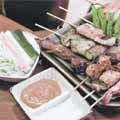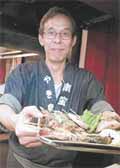|
 |
Yakitori – From The Master Himself WHILE fugu is a rarefied Japanese delicacy for the upper echelons, yakitori epitomises everyman gastronomy. Often featuring rough-and-tumble settings and limited chicken-morsels-on-skewer menus, yakitori-yas used to attract a wholly male clientele, alienating the women. All that changed when yakitori chef Fumio Tanaka opened the first Nanbantei restaurant in Tokyo some 25 years ago. He wanted to allow women and children to enjoy yakitori in a more congenial surrounding and so created a restaurant-like setting. He also introduced nontraditional ingredients such as pork, beef, even vegetables - a new style of yakitori-yas that is till now the standard. Today, there are 14 Nanbantei outlets in Japan and 13 in other countries including Singapore. Chef Tanaka is currently at the 20-year-old Singapore outlet and recently introduced new items, including the hard-to-get pork neck (with a distinctive flavour) as well as okura (lady's fingers) stuffed with cheese and sliced pork. Delectable Nanbantei stalwarts such as unctuous salmon belly, succulent beef tongue and the lovely shiso-wrapped pork all attest to the chef's genius. But what really matters is the chef's skill. A good yakitori chef must be a great multi-tasker - he must keep a keen eye on whatever is on the grill, season accordingly to the ingredient (miso paste for beef, gingery soy sauce for seafood), remember food orders well, chat with counter customers - and all without getting a piece of meat, or his fingers, burnt. Another important skill: sprinkling salt evenly over the grill. "It sounds simple, but most of us canít do that," said the Singapore outlet's owner, the English-speaking Hisaki Deguchi, who served as our translator. Master chefs can dust the salt over the entire skewer using just three fingers and one flick. A reporter in Japan once brought an electronic scale and challenged chef Tanaka to pinch and sprinkle exactly one-tenth of a gram of salt. He passed the test, 10 times over! At Nanbantei, the chefs use pure sea salt from Japan that costs six times more than normal salt. Known as hakata, it is less sharp and salty than local salt. Hard, aromatic charcoal is also used. White charcoal, or binchyotan, is prized for its excellent heat retention (it can burn up to 1,000°C) without producing any odour (so it does not spoil the flavour) or flame (which scorches food). The amount of know-how behind a simple stick of yakitori is amazing. But with the advent of fastfood-style yakitori chains such as Tori-Q, what's the future for traditional outfits? Said Tanaka: "I strongly believe that I don't want to be an everything restaurant, but a specialist. For good yakitori, people will come to Nanbantei." And also just to revel in the perfection of this highly evolved, albeit humble, cuisine, we add. Nanbantei is at Far East Plaza, #05-132, 14 Scotts Road. Tel: 6733-5666. OPENING HOURS (daily): Lunch: Noon to 2.15pm; Dinner: 6.30pm to 10.30pm. UOB Dining Privileges |
 The
lanky, mild-mannered, chef's favourite yakitori creation is goose
liver from Israel, when he was opening an outlet there.
The
lanky, mild-mannered, chef's favourite yakitori creation is goose
liver from Israel, when he was opening an outlet there.